

This is vital not only due to the quality of the steel but also due to the labor required to cut the sheet. The thickness of a steel sheet is one of the things to think about. The standards used to develop the gauge system were based on the weight of fabric in a specified size sheet. The smaller the gauge number, the thicker the sheet. The larger the gauge number, the thinner the sheet. While some people measure sheet thickness in millimeters, the ideal dimensions is in gauges. Factors to Consider when Determining Steel Sheet Sizes Gauge So, when dealing with any product, always remember to use the steel gauge chart to ascertain its size. This will in turn reserve the quality and integrity of your product. Some sensitive applications require that you use the exact sizes of steel sheets. This will in turn ensure that you don’t spend more money on the steel sheet. You are aware that steel sheets are quite pricey hence you have to be very sparing when it comes to putting them into real applications.īy measuring the exact thickness, you will avoid using unnecessarily thicker steel sheets. One of the reasons is to minimize wastage of the metal sheet. But, what is the importance of this action? Why Know the Size of Steel Sheet?Īs we have seen, steel metal sheet gauge will help you know the exact thickness of a steel sheet. For instance, if your sheet is 0.2391 inches, it might have a gauge of 3. If your measurement was 55 millimeters, for instance, you’d be left with 2.16535 inches.Ĭompare the thickness of your sheet in inches to a sheet gauge chart to seek out the right gauge of that specific piece. Multiply the number of millimeters by 0.03937 to convert to inches. Use the millimeter hash marks to seek out the most accurate measurement possible. Use tape to determine the thickness of your sheet piece. Then, using a steel sheet gauge chart, you’ll match that thickness up with the acceptable numbered gauge of your product. If you would like to seek out out what gauge your sheet is, measure its thickness employing a regular tape.

The higher the values on the gauge, the thicker the piece is in millimeters. The gauge of a sheet of metal is used to give an accurate reference to how thick the steel is.
#STEEL 18 GAUGE HOW TO#
How to Measure Sheet Metal Gauge Thickness From there, the steel gauge chart has been evolving up to the latest charts. It is at this point that artisans started denoting the metal sheets by their diameter vs. However, this method was quite hectic, especially when a buyer wanted a particular weight of steel sheet but did not specify the diameter. One of the methods that were used for measuring the steel metal sheets was the gravimetric method. For instance, the diameter of the steel wires had to be quantified before being used. There was a dire need for craftsmen and artisans to use accurate metal sheets so that the products can have physical and structural integrity. That was when metal sheets were used for various commercial activities. Sheet steel gauge chart draws its history back to the age of the industrial revolution. There are several different types of sheet metal gauge systems used today, with specific gauge designations used for specific metal types.įor instance, in one gauge system, 18 gauge steel measures 0.0478 inches thick, but 18 gauge aluminum is 0.0403 inches thick.ĭue to the varying thicknesses, a gauge chart should be used to make sure the metal meets the specified dimensions. For instance, a 10 gauge steel sheet with a thickness of 0.1345 inches will weigh 41.82*0.1345 = 5.625 pounds per sq ft. This is often referred to as the Manufacturers’ Standard Gage for Sheet Steel.įor other materials, like aluminum and brass, the thicknesses are going to be different. Sheet metal thickness gauges for steel are fully based on the weight of 41.82 pounds per sq ft per inch of thickness. The gauge number “18” holds no relevance to the particular measurements. For instance, 18 gauge steel, consistent with a gauge conversion chart, is 0.0478 inch or 1.214 millimeters. And this is where a steel gauge chart comes in.Ī steel sheet gauge conversion chart is often used to determine the particular thickness of the sheet in inches or millimeters. Gauges are neither standard nor metric, and therefore the values are independent of these measurement systems. Gauges are usually used to specify the thickness of a steel sheet. It is imperative to note that as the gauge number increases, the steel thickness decreases.


 0 kommentar(er)
0 kommentar(er)
